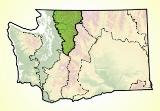 © Pete Saloutos/Panoramic Images (Washington Title Image Large)
© Pete Saloutos/Panoramic Images (Washington Title Image Large)

North Cascades: People in the Ecoregion
People have inhabited the North Cascades for at least 8,400 years, with some evidence indicating habitation 10,000 years ago. The ancestors of Coast Salish and Interior Salish speaking peoples lived in the area, and archaeological evidence shows that they hunted, gathered, and processed plant foods here.
Euro-American settlement within the remote and rugged North Cascades occurred slowly over many years. Access was difficult and the good farmland scarce. In addition, homesteaders may have been discouraged by the lack of surveyed lands and the creation of the Washington Forest Reserve in 1897. The Washington Forest Reserve eventually became Mt. Baker-Snoqualmie National Forest.
Much of the North Cascades ecoregion belongs to the public and is administered by the National Park Service, the USDA Forest Service (Mt. Baker-Snoqualmie National Forest), and the Washington Department of Natural Resources.
The North Cascades National Park Service Complex is made up of three units managed as one: North Cascades National Park, Ross Lake National Recreation Area, and Lake Chelan National Recreational Area. Over 93% of the park complex is managed as the Stephen T. Mather Wilderness, established by Congress in 1988.
Mt. Baker-Snoqualmie National Forest encompasses a large portion of the west side slopes of the North Cascades Ecoregion. About 41% of this National Forest is designated wilderness.
The Upper Skagit River Hydroelectric Project, which supplies about 20% of the electrical power used in the city of Seattle, encompasses three dams on the Skagit River. Planning began in 1905, and construction on the dams was finished in 1961.
Private land in the ecoregion is a legacy of the 1864 Northern Pacific Land Grant, which bestowed vast amounts of land on the railroad that built a trans-continental link to the Pacific Northwest. Many towns in the region started as places that housed and fed railroad construction workers.
The Weyerhaeuser Company moved into the region just over a century ago, through a 900,000-acre land sale by railroad baron James J. Hill to his Minnesota neighbor, timber magnate Frederick Weyerhaeuser. The Plum Creek Timber Company is an independent company but has its origins as the Burlington Northern railroad subsidiary that managed the company's timber holdings from western Montana to the Washington Cascades.
The economic base for people in the North Cascades ecoregion is primarily forestry and tourism.
For details of this ecoregion within Washington, click a subheading in the left column.
View the more general description of this ecoregion in North America



